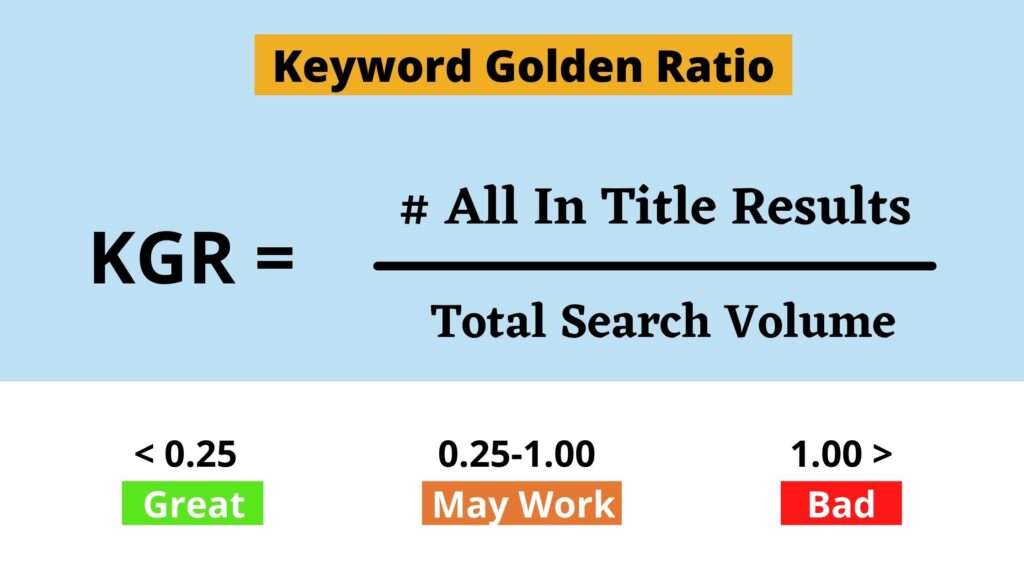In this article, you are going to read about Keyword Golden Ratio, and how to use KGR keywords.
When your site is fresh new, it can be difficult to get out of the Google sandbox. Even if you use all of the recommended SEO techniques, it may take months before you notice any returns.
The Keyword Golden Ratio (KGR) will assist you in breaking free from the sandbox and ranking in Google within days (if not hours)!
We’ve seen sites rise from no search engine traffic to page 1 in less than a week using this strategy!
What Is Keyword Golden Ratio?
The Keyword Golden Ratio (KGR) is a keyword selection strategy (or hack) that creators claim will help you identify extremely low competition long-tail terms in Google that might potentially rank in the top 50 within 24 hours, generating traffic and increasing revenue for a new website (or a few days).
If you have a larger site in the SERPs, you might be able to take on some medium tail keywords, fat tail keywords, or more competitive phrases in general.
KGR is a simple quantitative measurement of competitiveness for long-tail keywords or phrases based on the number of Google “allintitle” results per monthly search volume (less than 250).
In other words, the ratio indicates how many searches result an individual user would find based on the keyword’s search volume in the SEO title (less than 250).
The output of this computation will provide you with three ranges from which to make assumptions about a keyword’s competitiveness: less than 0.25, between 0.25 and 1.00, and larger than 1.00.
The KGR is a simple formula that divides the number of Google search results with a term in the title by the monthly search volume for that keyword (where search volume is 250 or less).

Keyword Golden Ratio Formula
The golden ratio’s formula is as follows:
KGR = (Number of Google “Allintitle” Results) / (Monthly Search Volume)

The lower the KGR value, the less competition your keyword has and the faster you will rank on Google.
It’s probably too difficult to rank on Google if your term has a ratio greater than 1. Finding a more realistic (and less competitive) longtail keyword is a better option.
If your KGR is less than 0.25, your page should appear in Google’s top 100 within a few days of being indexed. This is regarded as a good KGR.
If your KGR is between.25 and 1, you’ll still rank in the top 250 slots on Google quite soon.
If the KGR is larger than one, the keyword is competitive, even if the search volume is modest (under 250).
What Is allintitle?
“Allintitle” is a Google advanced search operator that you can use to limit your search results to web pages/sites that include a certain long-tail keyword phrase in the title of the content.
Assume you’re looking for the “best paraphrasing tools .” You would type the following query into the search field if you just want to see sites with this exact question in the web page title:
allintitle:best paraphrasing tools for SEO

It’s important to keep in mind that placing a space after the colon and using quotes will reduce the amount of “allintitle” sites, possibly resulting in an incorrect KGR ratio.
Once you’ve submitted your “allintitle” search command correctly, Google will only show you pages with the phrase “best paraphrasing tools for SEO” in the title. The number of locations found can then be entered into your KGR formula, and the data ranges indicated above can be used to assess if the word is KGR compliant.
Tips to Use KGR Keywords
1. Keep in mind that there is a maximum of 250 monthly searches; if you use more than that, the strategy will not work.
2. The more terms you have in your keyword phrase, the better. Use keyword modifiers like why, when, how, what, best way, problem, get rid of, sizes, list, etc. if you need to add words to your term.
3. KGR keywords are difficult to utilize without sounding odd due to their length. As a result, don’t push it. Just make sure your KGR word appears twice in the article: once in the title and once in the body.
4. A term with fewer than 70 results in an ‘allintitle’ search is a solid contender for a KGR keyword in general.
5. This is much easier to find KGR keywords related to information than it is to find keywords related to things. As a result, taking sites developed around information-related KGR keywords and linking them to your product pages is a fantastic idea. The authority of your product pages will be enhanced as a result of the information pages.
Longtail vs Short Tail Keywords for KGR
In the search for organic traffic, logic would dictate that developing a content strategy concentrated on short-tail keywords would be your best hope for generating web page visits.
After all, these are the terms that generate the most traffic, and traffic, after all, is what leads to conversions, right?
Wrong!
Not altogether incorrect, to be sure.
Yes, short-tail keywords are more likely to generate high-volume search results on Google. Given a large number of competitors, however, having your niche website included on the first search engine results page for a short-tail term will be nearly impossible. This is particularly true for new or inexperienced websites.
Remember that conversions are driven by uniqueness.
When you use the Keyword Golden Ratio with long-tail keywords, you’ll be able to produce results that are more personalized to your company’s needs and are much more likely to result in increased traffic and conversions.
Reasons Why You Can Use KGR
To stay motivated
All know that SEO isn’t something that happens overnight. New website rankings require a long-term and concerted effort. This effort is supported by the ratio, which provides you with much-needed little wins by focusing on low-hanging fruit. Small victories eventually add up to big victories, boosting your confidence with great outcomes.
Helps You to Prioritize Your SEO Efforts
Rather than taking a “needle in a haystack” approach to SEO, the KGR uses an organized and structured technique to establish the framework for successful SEO. KGR not only assists you in reducing the extent of your keyword research to phrases with lesser search traffic, but it also makes it simple to select which material to publish first thanks to its ratio.
Help you to Outrank Your Competitors
While you may not believe it, it’s quite doubtful that the majority of your competitors use data to determine their search phrases. The KGR is a manual method that will offer you actionable data if you add a step or two to your SEO research strategy.
Pitfalls Of Keyword Golden Ratio
The Keyword Golden Ratio is a wonderful tool for increasing traffic to your website (particularly a new niche site). It is not, however, without its share of pitfalls. SEO blunders are always lurking around the corner in our line of work, and the KGR formula is no exception.
With industry markets getting more competitive, we’ll wrap up our look at the Keyword Golden Ratio by going through some of Doug Cunnington’s “no-nos” when it comes to using KGR keywords.
While the list below may seem self-evident to a seasoned marketer, keep in mind that keyword research best practices are continuously changing.
1. Keyword stuffing
Keyword stuffing should be avoided. Don’t overuse the keyword phrase in your article. KGR terms are typically lengthier than standard keyword phrases, with some containing four or more syllables.
Longer phrases should be avoided in the text as much as possible. Using a big keyword phrase eight times in a post would be strange and odd.
If you used “how to optimize the image for SEO” more than a couple of times, it would appear strange.
2. KGR Keyword Scarcity
One of the most common criticisms of the KGR formula is how difficult it is to identify keywords that are KGR compliant.
However, it’s vital to remember that the Keyword Golden Ratio, like any other ranking approach, is a skill that must be learned and perfected.
When it comes to discovering KGR compatible search phrases, there is no such thing as a “hack.” That, in our perspective, is what makes the Keyword Golden Ratio so appealing: it’s an acquired skill that takes time and effort to master.
While nothing beats practice, research tools like Ahrefs and SEMrush can certainly help speed up the process. We suggest using your favorite keyword research tool online and following the methods indicated above. With a little perseverance, you’ll be able to generate robust lists of KGR compliant phrases in no time.
3. Failed to rank on KGR keywords
Another issue of the KGR formula is that, even when their KGR score is between 0.25 and 1 (i.e., well-positioned), or less than 0.25, KGR compliant search phrases will frequently fail to rank (i.e., ideal).
Google is once again concentrating on search intent.
Even if you’re using KGR-compliant keywords in your ranking strategy, there could be a variety of other factors affecting your position.
To begin with, the market may be crowded with websites that are comparable to yours. Second, there may already be a handful of “untouchable” authoritative sites for your industry on the internet (i.e., the medical device market). Third, you should always keep in mind that searchers prefer digital material over website content (i.e., Youtube).
If Google isn’t ranking sites that are similar to yours for a certain KGR keyword, even if it is KGR compliant, you should consider eliminating the phrase.
Conclusion
The Keyword Golden Ratio is a catchy-sounding approach that aims to provide quick results for people who want to rank quickly and generate money. However, like with most aspects of SEO, it may not always work or stand up against changing competition.
To feel like they’re doing things correctly, new site owners need traffic and rapid successes. KGR advocates believe that providing low-competition keywords to exploit, can help you rank in the top 50 in a short period of time.
Keywords in SEO titles, according to KGR, provide a strong, competitive ranking indication. While it is, it is only one of numerous elements we consider, which also include the permalinks themselves and the holy trinity (power, authority, relevance) of the website.
KGR, on the other hand, is founded on good reasoning and is simple to implement. To get started, you’ll only need a few basic tools. Giving it an attempt won’t take much time or money, and it could pay off handsomely.
It’s up to you to determine if you believe in basic success formulas or whether you want to explore a little deeper into more extensive search term tactics.




